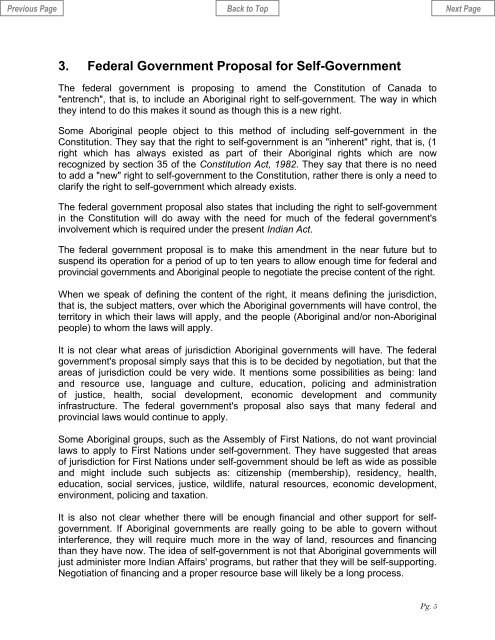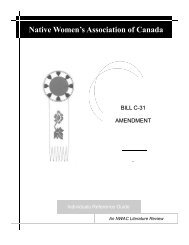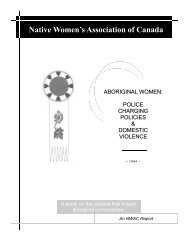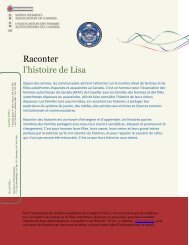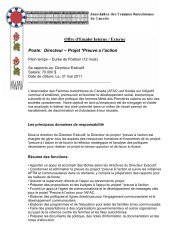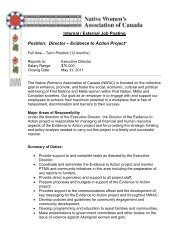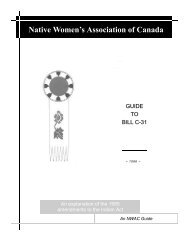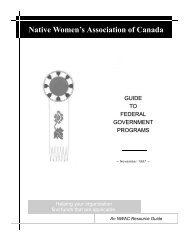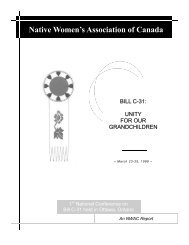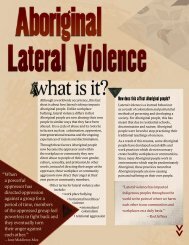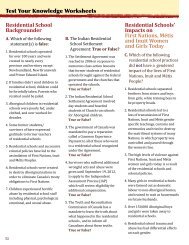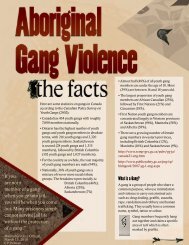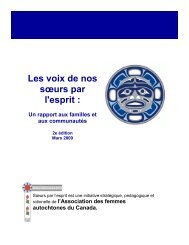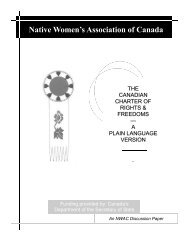Native Women & Self-Government - Native Women's Association of ...
Native Women & Self-Government - Native Women's Association of ...
Native Women & Self-Government - Native Women's Association of ...
Create successful ePaper yourself
Turn your PDF publications into a flip-book with our unique Google optimized e-Paper software.
3. Federal <strong>Government</strong> Proposal for <strong>Self</strong>-<strong>Government</strong>The federal government is proposing to amend the Constitution <strong>of</strong> Canada to"entrench", that is, to include an Aboriginal right to self-government. The way in whichthey intend to do this makes it sound as though this is a new right.Some Aboriginal people object to this method <strong>of</strong> including self-government in theConstitution. They say that the right to self-government is an "inherent" right, that is, (1right which has always existed as part <strong>of</strong> their Aboriginal rights which are nowrecognized by section 35 <strong>of</strong> the Constitution Act, 1982. They say that there is no needto add a "new" right to self-government to the Constitution, rather there is only a need toclarify the right to self-government which already exists.The federal government proposal also states that including the right to self-governmentin the Constitution will do away with the need for much <strong>of</strong> the federal government'sinvolvement which is required under the present Indian Act.The federal government proposal is to make this amendment in the near future but tosuspend its operation for a period <strong>of</strong> up to ten years to allow enough time for federal andprovincial governments and Aboriginal people to negotiate the precise content <strong>of</strong> the right.When we speak <strong>of</strong> defining the content <strong>of</strong> the right, it means defining the jurisdiction,that is, the subject matters, over which the Aboriginal governments will have control, theterritory in which their laws will apply, and the people (Aboriginal and/or non-Aboriginalpeople) to whom the laws will apply.It is not clear what areas <strong>of</strong> jurisdiction Aboriginal governments will have. The federalgovernment's proposal simply says that this is to be decided by negotiation, but that theareas <strong>of</strong> jurisdiction could be very wide. It mentions some possibilities as being: landand resource use, language and culture, education, policing and administration<strong>of</strong> justice, health, social development, economic development and communityinfrastructure. The federal government's proposal also says that many federal andprovincial laws would continue to apply.Some Aboriginal groups, such as the Assembly <strong>of</strong> First Nations, do not want provinciallaws to apply to First Nations under self-government. They have suggested that areas<strong>of</strong> jurisdiction for First Nations under self-government should be left as wide as possibleand might include such subjects as: citizenship (membership), residency, health,education, social services, justice, wildlife, natural resources, economic development,environment, policing and taxation.It is also not clear whether there will be enough financial and other support for selfgovernment.If Aboriginal governments are really going to be able to govern withoutinterference, they will require much more in the way <strong>of</strong> land, resources and financingthan they have now. The idea <strong>of</strong> self-government is not that Aboriginal governments willjust administer more Indian Affairs' programs, but rather that they will be self-supporting.Negotiation <strong>of</strong> financing and a proper resource base will likely be a long process.Pg. 5


